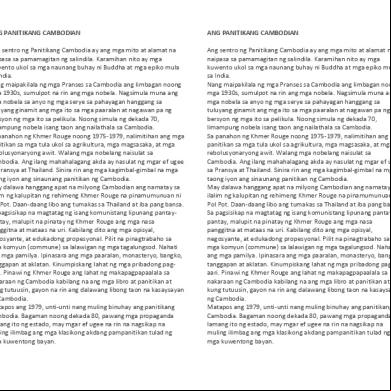Cambodian Architecture 6197
This document was ed by and they confirmed that they have the permission to share it. If you are author or own the copyright of this book, please report to us by using this report form. Report 2z6p3t
Overview 5o1f4z
& View Cambodian Architecture as PDF for free.
More details 6z3438
- Words: 444
- Pages: 27
Cambodia • South East Asia
Khmer Empire • Jayavarman II-universal monarch(chakravartin) • 9th century to early 15th century
• Khmer People –predominant ethnic group in cambodia • Almost 90% of their population
• Golden age=Angkor period
Architecture and Religion • Buddhism was the one dominant in Cambodia, however through the introduction of Hinduism, it shared a significance in their architecture when it flourished through the land.
Architecture • Khmer Architecture focused on creating temples. • Religious and Non-Religious • Khmer Architecture mostly reflects on their religion which is Hinduism
Architecture • Motifs of Apsaras and DevatasPlayed a big role.
Architecture & Materials • Stone- main used from religious temples • Wood-for none religious structures • Sandstones • bricks This results to the Stone temple still can be seen unlikely the wood structures that has been washed out.
GEOGRAPHY CAPITAL: PHNOM PENH ANCIENT NAME: KAMBUJA 90% KHMER LOCATION: BORDERING THE GULF OF THAILAND, VIETNAM, AND LAOS AREA: TOTAL: 181,040 SQ KM LAND: 176, 520 SQ KM WATER: 4 520 SQ KM
COUNTRY’S AREA CONSISTS OF ROLLING PLAINS TONLE SAP (GREAT LAKE) MEKONG RIVER
NATURAL RESOURCES (USED IN BUILDING/ STRUCTURES)
BRICK
STUCCO
WOOD
SANDSTONE
LATERITE
TECHNOLOGY • BRONZE TOOLS • USED IN MAKING TOOLS, RITUAL OBJECTS, WEAPONS, ORNAMENTS • USED OFBONZE CASTING INFLUENCEDBY CHINA AND INDIA
• LIKE THE STATUE OF THE RECLINING BUDDHA CARVED OUT FROM BRONZE
SOCIO- CULTURAL • HOMOGENOUS COUNTRY; 95% SPEAKS KHMER • MARRIAGE • LASTED 1 ½ DAYS, FORMELY 3 DAYS
• SOCIAL • MATRIARCHAL
• CUSTOMS • HEAD- CONTAINS THE SOUL; MOST SACRED • “SAMPEAH” AND “CHHBAPP”
CLOTHING
KRAMA
SAMPOT
SARONG
SOCIO- CULTURAL • APSA DANCE • BASED ON RAMAYANA
• NANG SBEK(SHADOW THEATER) • NANG SBEK THOM • NANG SBEK TOCH • SBEK PAOR
CAMBODIAN TIMELINE
ARCHITECTURAL CHARACTER • ANGKORIAN BUILDERS USED BRICK, SANDSTONE, LATERITE AND WOOD AS MATERIALS. THE RUINS THAT REMAIN ARE OF BRICK, SANDSTONE AND LATERITE, THE WOOD ELEMENTS HAVING BEEN LOST, TO DECAY AND OTHER DESTRUCTIVE PROCESSES.
CENTRAL SANCTUARY • THE CENTRAL SANCTUARY OF AN ANGKORIAN TEMPLE
Angkor Wat(Holy Temple) • • • •
Angkor, Cambodia Built by King Suryavarman II Early 12th century Masterpiece of the Angkorian Architecture, was dedicated to the God Vishnu
Angkor Wat
• *world’s largest religious building • Made of sandstone
The Bayon Temple • Famous and richly decorated • Built late 12th century • Was the official state of the Mahayan Buddhist King Jayavarman VIII • Was dedicated to Buddha
The Bayon Temple • Most distinct feature-multitude of serene smiling stone faces on many of the towers.
Decling(14th century) • Khmer empire suffered a decline which historian says the reason is some changes in their religion.
Khmer Empire • Jayavarman II-universal monarch(chakravartin) • 9th century to early 15th century
• Khmer People –predominant ethnic group in cambodia • Almost 90% of their population
• Golden age=Angkor period
Architecture and Religion • Buddhism was the one dominant in Cambodia, however through the introduction of Hinduism, it shared a significance in their architecture when it flourished through the land.
Architecture • Khmer Architecture focused on creating temples. • Religious and Non-Religious • Khmer Architecture mostly reflects on their religion which is Hinduism
Architecture • Motifs of Apsaras and DevatasPlayed a big role.
Architecture & Materials • Stone- main used from religious temples • Wood-for none religious structures • Sandstones • bricks This results to the Stone temple still can be seen unlikely the wood structures that has been washed out.
GEOGRAPHY CAPITAL: PHNOM PENH ANCIENT NAME: KAMBUJA 90% KHMER LOCATION: BORDERING THE GULF OF THAILAND, VIETNAM, AND LAOS AREA: TOTAL: 181,040 SQ KM LAND: 176, 520 SQ KM WATER: 4 520 SQ KM
COUNTRY’S AREA CONSISTS OF ROLLING PLAINS TONLE SAP (GREAT LAKE) MEKONG RIVER
NATURAL RESOURCES (USED IN BUILDING/ STRUCTURES)
BRICK
STUCCO
WOOD
SANDSTONE
LATERITE
TECHNOLOGY • BRONZE TOOLS • USED IN MAKING TOOLS, RITUAL OBJECTS, WEAPONS, ORNAMENTS • USED OFBONZE CASTING INFLUENCEDBY CHINA AND INDIA
• LIKE THE STATUE OF THE RECLINING BUDDHA CARVED OUT FROM BRONZE
SOCIO- CULTURAL • HOMOGENOUS COUNTRY; 95% SPEAKS KHMER • MARRIAGE • LASTED 1 ½ DAYS, FORMELY 3 DAYS
• SOCIAL • MATRIARCHAL
• CUSTOMS • HEAD- CONTAINS THE SOUL; MOST SACRED • “SAMPEAH” AND “CHHBAPP”
CLOTHING
KRAMA
SAMPOT
SARONG
SOCIO- CULTURAL • APSA DANCE • BASED ON RAMAYANA
• NANG SBEK(SHADOW THEATER) • NANG SBEK THOM • NANG SBEK TOCH • SBEK PAOR
CAMBODIAN TIMELINE
ARCHITECTURAL CHARACTER • ANGKORIAN BUILDERS USED BRICK, SANDSTONE, LATERITE AND WOOD AS MATERIALS. THE RUINS THAT REMAIN ARE OF BRICK, SANDSTONE AND LATERITE, THE WOOD ELEMENTS HAVING BEEN LOST, TO DECAY AND OTHER DESTRUCTIVE PROCESSES.
CENTRAL SANCTUARY • THE CENTRAL SANCTUARY OF AN ANGKORIAN TEMPLE
Angkor Wat(Holy Temple) • • • •
Angkor, Cambodia Built by King Suryavarman II Early 12th century Masterpiece of the Angkorian Architecture, was dedicated to the God Vishnu
Angkor Wat
• *world’s largest religious building • Made of sandstone
The Bayon Temple • Famous and richly decorated • Built late 12th century • Was the official state of the Mahayan Buddhist King Jayavarman VIII • Was dedicated to Buddha
The Bayon Temple • Most distinct feature-multitude of serene smiling stone faces on many of the towers.
Decling(14th century) • Khmer empire suffered a decline which historian says the reason is some changes in their religion.










